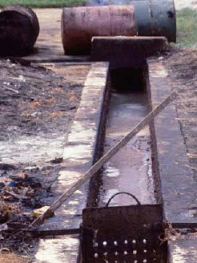 Regardless of whether it is domestic or industrial wastewater, toxicity tests need to be carried out in order to assess the degree of removal and effectiveness of the whole treatment system processes. This is important not only to ensure that the wastewater discharge is able to meet the quality standards and guidelines set by the government but also to determine the harmful effects of the effluent towards the environment, living organisms like animals and aquatic species and most important, human population. Generally in order to find out each and every single pollutant or chemical still left present in the wastewater after the treatment steps can be very tedious and considered a time-consuming process. Thus it would be a more economical and viable approach to conduct a whole effluent toxicity test using bio assay organisms which is carried out laboratory scale by introducing aquatic species into test aquariums containing different concentrations of effluent and then study the overall effects on their responses and exposure over time.
Regardless of whether it is domestic or industrial wastewater, toxicity tests need to be carried out in order to assess the degree of removal and effectiveness of the whole treatment system processes. This is important not only to ensure that the wastewater discharge is able to meet the quality standards and guidelines set by the government but also to determine the harmful effects of the effluent towards the environment, living organisms like animals and aquatic species and most important, human population. Generally in order to find out each and every single pollutant or chemical still left present in the wastewater after the treatment steps can be very tedious and considered a time-consuming process. Thus it would be a more economical and viable approach to conduct a whole effluent toxicity test using bio assay organisms which is carried out laboratory scale by introducing aquatic species into test aquariums containing different concentrations of effluent and then study the overall effects on their responses and exposure over time.So how do we come up with the conclusion and measure how toxic the effluent is? Generally there are different test protocols depending on which type of toxicity tests being conducted and it can be classified according to its effects (whether long term, short or intermediate) and the methods applied. The shrimp test for example is based on the growth, reproduction and survival of the species after one week period. Whether it will continue to live at the end of the test period, how it will affect it reproduction capability by observing the presence of eggs or how it jeopardize the growth rate, will all determine the state and severity of the toxic levels. Acute toxicity is the level at which responses are observed after 48 or 96 hours. The common term such as LC50 represents the concentration of effluent capable of reducing the mortality rate of the test subjects to 50 percent while EC50 is the measurable negative effects that appear on 50 percent of the test population. Chronic toxicity on the other hand, is the continual effects that are shown on the test subjects that extend beyond the duration of 1/10 of the overall lifespan. Based on these results, criteria were developed and units assigned in order to measure and track on the compliance status.
Removal of toxic compounds can be done via several methods and depending on whether it is refractory toxic, volatile organics or heavy metals, there are different types of treatment processes that can be applied. Most commonly used approaches are carbon adsorption, chemical oxidation, anaerobic treatment, wet air oxidation, chemical precipitation, ion exchange and while there is no specific method that is considered the best, generally the idea is to select the type of treatment method capable of removing the widest range of chemicals or toxic compounds present in the highest concentration. Depending on requirements, the systems can also combine different treatment processes into one. Usually removal of toxic substances is done during the pre-treatment stage prior to feeding the influent to the wastewater facilities and the rest of residual concentration still left will be removed at the secondary treatment stage. The table below will list down the recommended treatment processes suited to which type of pollutants present in the wastewater.
| Characteristics of Toxic Pollutants | Type of Treatment |
| Volatile compounds | Air or steam stripping Carbon absorption Chemical oxidation |
| Refractory toxic organics | Anaerobic treatment Wet air oxidation Carbon absorption Chemical oxidation |
| Heavy metals | Chemical precipitation Ion exchange |


